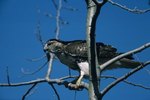Seagulls belong to family Laridae, which also includes terns. In North America, there are 23 species of gulls. Lifespan of seagulls varies, depending on the species. Some species, such as herring gulls, have a lifespan of 30 or more years, while others, such as ring-billed gulls, live for 10 to 15 years.
Lifespan of Seagull
The lifespan of seagull is affected by several factors, such availability of food and protection from predators as well as extreme weathers. Hence, it is but natural that seagulls living in captivity, such as in zoos, have longer lifespans compared to those living in the wild. But if young gulls in the wild survive the rigors of their first year, their chances of survival increase significantly and keep increasing with each passing year.
There is recorded evidence to show that a herring gull named Gull Dick visited the same neighborhood for 24 years. He used to visit Brenton's Reef lightship at Narragansett Bay every from from Oct. 12 to April 7 and during this visit the crew fed the bird boiled pork and fish.
Similarly, there are records of many gulls living longer than other members of their species.
Description
These birds are large to medium in size with white or gray feathers. Depending on the species, gulls are between 11 and 30 inches in size. Many species have black markings on their heads or wings. Their bills are stout, strong and slightly hooked and their feet are webbed. Their wings are long and pointed, having a wingspan of 3 to 4 feet. They are closely related to terns and distantly to auks. Coloration of many seagulls is seasonal or may change as they mature. During the breeding season, generally adult seagulls have white heads. These include herring gulls, great black-backed gulls, western gulls and glaucous-winged gulls. However, some species, such as Bonaparte's gulls and Franklin's gulls have dark-colored hoods during the breeding season. During winter, gulls with white heads develop streaks on their head, while hooded gull species tend to have a dark spot on the head.
Seagull Habitat
Gulls, more often known as seagulls, are seen in coastal areas on cliffs, coastal towns and low-lying coastal regions. However, they are also seen inland, around dumpsters and parking lots. Gulls are comfortable living inland or along the shore, as long there is food supply in the vicinity. Seagulls are primarily scavengers, but they eat fish, shrimps, prawns, small birds and mammals, eggs, crabs, carrion, grains and edible rubbish. The birds prefer scavenging for food around dumpsters and fishing harbors rather than catching fish at sea.
Breeding
Seagulls lay just a single clutch of eggs once a year. The bird nests in large colonies, with each gull laying between 2 and 3 eggs. The incubation period varies from species to species and generally both parents help to incubate the eggs. Nests are made from stones, sticks and twigs and are built on the ground. The young stay close to the nest for five to six weeks after hatching, and then they are ready to learn scavenging and hunting skills from their parents.
Seagull Control
Some people view seagulls as nuisance birds, as they damage crops and threaten human safety. Seagulls are known to collide with aircraft more often than any other birds. They also have a tendency to build their nests on rooftops and swoop down to snatch food while people are eating outdoors. As they tend to scavenge from dumpsters, there is a risk of transmitting diseases to humans when they roost near water reservoirs. Seagulls are considered migratory birds and hence are protected by federal laws. Many states in the United States also have laws to protect these birds. Hence, to take seagulls away from an area, professionals require a permit issued by the U.S. Fish and Wildlife Service. Bird-control professionals first have to use physical barriers and mechanical techniques to frighten away the birds. When these control methods fail, the permit is issued.
References
Photo Credits
-
Jupiterimages/Photos.com/Getty Images



